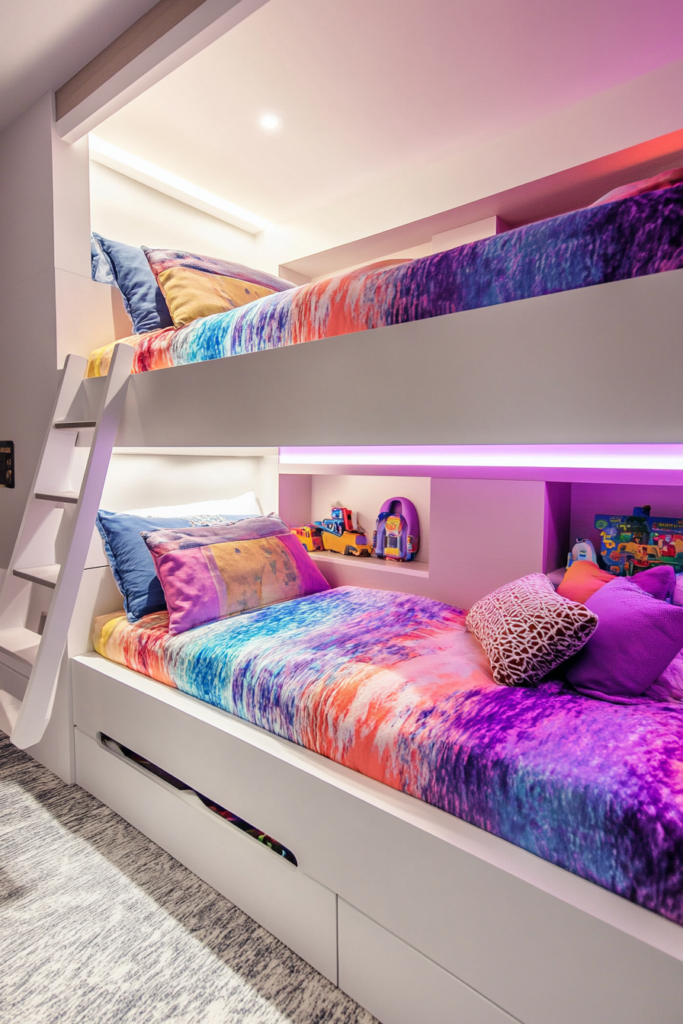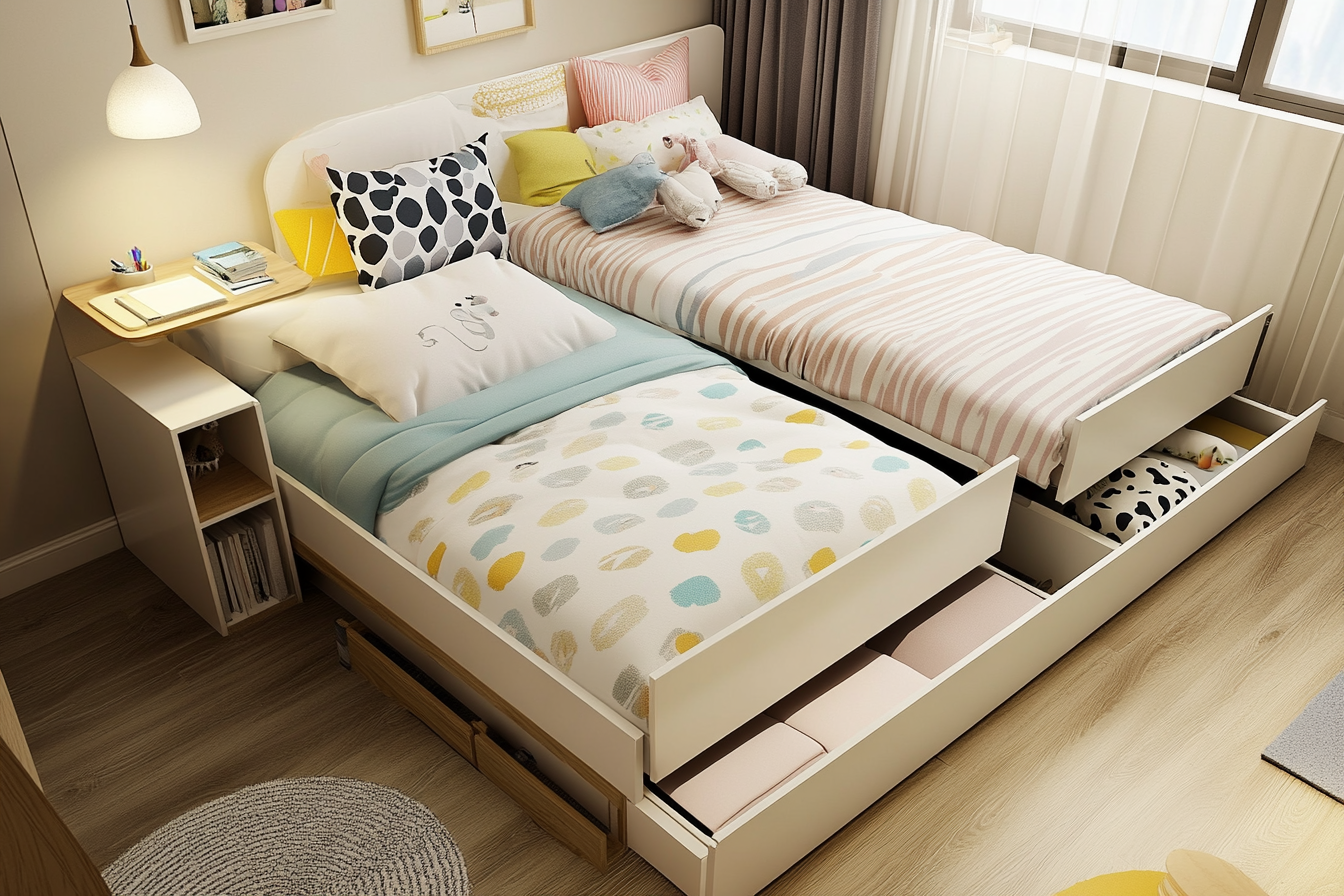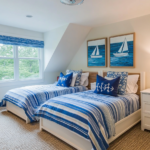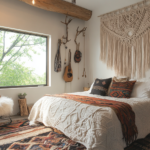Creating a shared bedroom for kids in a small space can be challenging. You want to ensure comfort, functionality, and organization while also giving each child their own space. The key is to get creative with furniture, storage, and layout choices to make the room feel both practical and inviting.
The good news is that even in a compact space, you can design a bedroom that feels spacious and stylish. By using clever storage hacks, space-saving beds, and personalized touches, you can create a cozy and functional room that both kids will love. Here are 21 smart ideas to help you transform a small shared bedroom into a perfect space for your little ones.
1. Bunk Beds for Maximum Space
Bunk beds are a classic space-saver and one of the best ways to accommodate two kids in a small room. They use vertical space efficiently, leaving more floor space for playtime and storage.
Modern bunk bed designs offer built-in shelves, stairs with drawers, and even study desks underneath. This not only makes the room feel more organized but also gives each child a cozy, personalized sleeping area.

2. Twin Beds with a Shared Headboard
If bunk beds aren’t an option, placing twin beds side by side can work just as well. A shared headboard connects the two beds visually, making the space feel cohesive.
For extra functionality, choose beds with built-in drawers underneath. This allows for easy storage of clothes, books, and toys, keeping clutter to a minimum.

3. Trundle Beds for Extra Space
Trundle beds are perfect for small shared rooms because they save space during the day. The second bed slides out when needed and tucks away effortlessly when not in use.
Many trundle bed designs come with storage drawers, making them even more functional. This is a great way to keep extra bedding, toys, or seasonal clothes out of sight.

4. Murphy Beds for Flexibility
If the shared bedroom is especially small, Murphy beds are a game-changer. These beds fold up into the wall, creating more floor space during the day.
Some designs even come with built-in desks or shelving, allowing the room to double as a study area or playroom when the beds are folded away.

5. Vertical Storage for More Floor Space
Using vertical space helps keep a small shared bedroom from feeling cluttered. Wall-mounted shelves provide extra storage without taking up valuable floor space.
Hanging organizers and stackable storage bins are also great solutions. They allow each child to store their belongings separately while keeping the room neat and tidy.

6. Shared Dresser with Labeled Drawers
Instead of squeezing two separate dressers into the room, a shared dresser with labeled drawers keeps everything organized. This allows both kids to have their own space while maximizing storage.
Color-coded labels or drawer organizers help avoid mix-ups. This makes it easier for kids to find their clothes and keep their space tidy without any confusion.

7. Bedside Cubbies Instead of Nightstands
Nightstands can take up too much space in a small room. A better alternative is wall-mounted cubbies or floating shelves beside each bed.
These provide a spot for books, water bottles, or nightlights without adding extra furniture. This keeps the floor open and makes the room feel more spacious.

8. Under-Bed Storage for Extra Organization
The space under the bed is often underutilized, but it can be a great place for hidden storage. Pull-out drawers or rolling bins can hold clothes, toys, and shoes, keeping the room clutter-free.
For seasonal items like blankets or holiday decorations, vacuum-sealed storage bags work well. This ensures less frequently used items stay out of the way but remain accessible when needed.

9. Hanging Baskets for Small Items
Small items like toys, art supplies, or accessories can quickly clutter a shared room. Hanging baskets or fabric organizers on the walls help keep everything within reach without taking up space.
These organizers make it easier for each child to store their personal items. This not only reduces mess but also helps kids take responsibility for their belongings.

10. Curtains or Canopies for Privacy
Even in a shared space, kids need a sense of privacy. Adding curtains, canopies, or fabric dividers around each bed creates a cozy, personal nook.
Sheer curtains allow for privacy while keeping the room airy. If more separation is needed, foldable room dividers can help create personal spaces without making the room feel cramped.

11. Designated Corners for Each Kid
Personalizing each child’s side of the room helps make sharing easier. Letting them choose their own bedding, wall art, and small decor items creates a space that feels uniquely theirs.
Using different paint colors or rugs can help define each child’s section. This ensures the room remains cohesive while allowing for individual expression.

12. Individual Storage Bins for Personal Items
To prevent confusion and mess, each child should have their own designated storage bins or baskets. This makes it easier to keep personal belongings separate and organized.
Color-coded storage solutions help distinguish each child’s items. This encourages responsibility and helps maintain a clutter-free environment.

13. Wall-Mounted Desks for Study Time
A shared bedroom doesn’t mean giving up on study space. Wall-mounted desks or foldable tables allow kids to have their own dedicated workspace without taking up too much room.
Installing shelves above the desk provides additional storage for books and school supplies. This keeps everything within reach and neatly arranged.

14. A Cozy Shared Play Area
Creating a shared play area encourages bonding and creativity. A small reading nook with cushions and bookshelves can make the space feel cozy.
If space allows, a mini craft station or whiteboard wall can give the kids a place for creative activities. This ensures the room remains both functional and fun.

15. Matching But Not Identical Decor
A shared bedroom looks best when it’s cohesive but still reflects each child’s personality. Choosing similar furniture pieces in different colors or patterns helps maintain balance.
This approach keeps the room visually harmonious while allowing each child to express their style. It also makes the space feel more inviting and personalized.

16. Multi-Functional Furniture for Maximum Space
Furniture that serves multiple purposes is essential in a small shared bedroom. Beds with storage, ottomans with hidden compartments, and foldable chairs help maximize every inch.
These smart furniture choices help make the room feel less crowded while keeping everything organized.

17. Light and Airy Colors for a Spacious Feel
Light colors make a small space feel bigger. Soft pastels, white walls, or neutral tones help create an airy and visually open atmosphere.
Adding mirrors and using wall sconces or string lights instead of bulky lamps also helps brighten the space.

18. Loft Space for Extra Room
If you have high ceilings, lofting the beds can free up space underneath for desks, a play zone, or additional storage. A double loft setup is perfect for twins.
For more flexibility, one lofted bed with a cozy nook below creates a comfortable reading or relaxation space.

19. Pegboards for Customizable Storage
A pegboard on the wall is a versatile solution for keeping things organized. Kids can hang baskets, shelves, or hooks for school supplies, books, and accessories.
This setup keeps frequently used items within easy reach while keeping the room tidy.

20. Over-the-Door Storage for Hidden Organization
The back of the bedroom door is often overlooked but can provide valuable storage space. Hanging organizers, shoe racks, or hooks help store essentials without taking up floor space.
This keeps everyday items accessible while reducing clutter in the rest of the room.

21. A Shared Bulletin Board for Creativity
A shared bulletin board or framed wire grid allows kids to display their favorite artwork, photos, or achievements. This adds personality to the space while keeping it neat.
Encouraging kids to change their displays regularly keeps the room fresh and fun.

Conclusion
In designing a shared bedroom for kids in a small space, creativity and efficiency are key. By incorporating smart sleeping arrangements, innovative storage solutions, and personalized touches, you can create a functional and enjoyable space that meets the needs of each child. From bunk beds that save floor space to individual storage bins that keep belongings organized, these 21 ideas offer a variety of ways to maximize a small shared bedroom. The goal is to design a room that feels spacious, organized, and uniquely theirs, making sharing a room a delightful experience for your kids.




